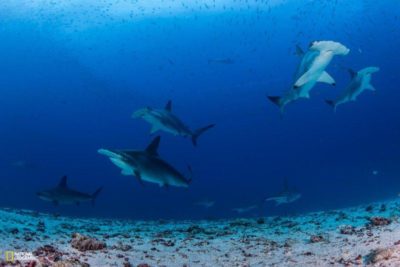By Silvia Sanchez Bor, May 11, 2016
 A group of hammerhead sharks swims over the sandy seafloor populated with garden eels at Darwin Island. These sharks are known for their ability to make sudden and sharp turns as the unique wide-set placement of their eyes allows them a vertical 360-degree view, which is ideal for stalking their prey. (Enric Sala/ National Geographic for National Geographic Pristine Seas)
A group of hammerhead sharks swims over the sandy seafloor populated with garden eels at Darwin Island. These sharks are known for their ability to make sudden and sharp turns as the unique wide-set placement of their eyes allows them a vertical 360-degree view, which is ideal for stalking their prey. (Enric Sala/ National Geographic for National Geographic Pristine Seas)
In a study published this week, scientists from the National Geographic Society and Charles Darwin Research Station found that Darwin and Wolf in the Galapagos Islands is home to the world’s largest shark biomass (the total mass of sharks in a given area) in the world.
This is especially welcome news as sharks continue to be hunted for the shark fin trade — with an estimated 73 million sharks killed annually. According to lead author Pelayo Salinas de Leon, “[T]he islands of Darwin and Wolf are jewels in the crown of the Galapagos,” due to the abundance of these top predators indicating a healthy marine ecosystem.
However, the two-year study funded by Helmsley Charitable Trust also found that reef fish in the area have been severely reduced due to overfishing. To protect its marine life, the Ecuadorian government created a marine sanctuary at Darwin and Wolf in March.
In response, WildAid is working in cooperation with the Galapagos National Park Service and the Ecuadorian Navy to enforce the new regulations via its comprehensive marine protection model. We aim to integrate new monitoring technology into the existing electronic surveillance system to to track all vessels, including small fishing vessels, entering the marine sanctuary to protect it from illegal fishing and other unsustainable practices.
The new marine sanctuary and monitoring technology is crucial to the protection of Galapagos marine biodiversity.